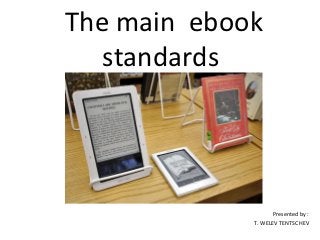
Main ebooks standards referred by t. welev tentschev
- 1. The main ebook standards Presented by : T. WELEV TENTSCHEV
- 2. Contemporary ebook standards • Main ebook standards: – EPUB – XML – DRM
- 3. Some basic INFO about e-book standards • What does it mean - EPUB? EPUB or ePub, ePUB, EPub, either epub is an abbreviation of electronic publication. This is an open, based on XML language, used for publishing of electronic books. This standard is the newest version of the Open eBook format. Nowadays EPUB is an official standard of the International Digital Publishing Forum (IDPF). It started in the year 2007.
- 4. The EPUB Standard The main features of EPUB: • Free of charge and open • You may enlarge the fonts • There is a vectoral graphics editor • Metadata included • You could use DRM
- 5. XML standard • XML Extensible Markup Language. It defines a set of rules for encoding documents in a both human-readable and machine readable format. • XML is totally platform independent so you can easily change documents between different systems.
- 6. DRM standard • DRM Digital Rights Management. It is based on cryptographic mechanisms and other methods to hide contents and to protect the system, to counteract some usage of data in the electronic format in a way contrary to the will of the publisher. • DRM is usually used to protect copyrights but in practice it can be used to restrict the usage of data in computer systems and multimedia. Critics call this DRM system a digital restrictions management .
- 7. Metadata – Metadata: • METS • EDI • TEI All of them show the author, title, the publisher etc. METS or Metadata Encoding and Transmission Standard . It is used for coding and processing of administrative and structural metadata regarding objects in a digital library, using XML.
- 8. Metadata and ebook standards • EDI Electronic Data Interchange. It determines how the exchange between computers clearly defined sides are able to format messages that define the content. The EDI defines the sequence of transmission of messages between the parties, each of which may be the sender or recipient. Data containing from the documents can be sent from the sender to the receiver by means of distance communication, or they can be transported to the storage media. The purpose of EDI is to eliminate multiple data entry and increase the speed and accuracy of information.
- 9. Something more about the metadata TEI Text Encoding Initiative – It is a standard for electronic representation of text along with information about its content, originally developed in SGML, then also in XML. • The primary design objective was to use the TEI encoding it to existing materials. It is now also used in the creation of new texts
- 10. Some other standards • SERU Shared Electronic Resource Understanding . It refers to the Joint Electronic Resources. This mechanism can be used instead of the License Agreement. • There is no license required here, just simple acknowledgment of SERU based which allows a quick access to the data. • SERU is not a legal document but it is a collection of statements agreed upon the publisher and subscribing institution. • Risks using SERU: It is not legally binding. • Positive featurures: It is good for small purchases, it includes so called Statements of common understandings for subscribing to electonic resourses, i.e. subscription language, the subscribing institution and its authorized users, use of materials, confidentiality and so on.
- 11. More about SERU • Advantages using SERU: -Libraries place and fill the order, sometimes the same day. It is possible because there’s no licence to negotiate and sign -With no license, it's quick and easy to place and manage an e-resource order -There's no commitment to use it every time if Library or Publisher prefers a license - You can get access fast. It's efficient and hassle-free
- 12. DOI standard • DOI Digital Object Identifier system. The DOI system provides a technical and social infrastructure for the registration and use of persistent interoperable identifiers for use on digital networks. It is also used for ebooks where itimplements the Handle system and the Index framework. The IDF or International DOI Foundation is the governance and management body for the federation of Registration Agencies providing DOI services and registration, and is the registration authority for the ISO standard (ISO 26324) for the DOI system.
- 13. Ebook standards Thank you for your attention There is a time for a discussion.